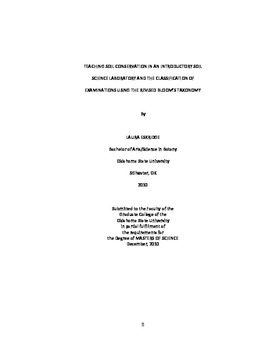| dc.contributor.advisor | Hattey, Jeff A. | |
| dc.contributor.author | Eskridge, Laura | |
| dc.date.accessioned | 2014-04-15T22:06:01Z | |
| dc.date.available | 2014-04-15T22:06:01Z | |
| dc.date.issued | 2010-12-01 | |
| dc.identifier.uri | https://hdl.handle.net/11244/9322 | |
| dc.description.abstract | Within soil science literature, there are adequate examples of soil conservation lesson plans; however, the majority have not been empirically tested to validate their efficacy. The objective of this study was to determine the effectiveness of two soil conservation teaching methods. Data was collected over two semesters with procedural changes occurring in the second semester. For the Simulator Group, students took a field trip to use a rainfall simulator and wind tunnel and completed post-lab questions and calculations. The Lecture Group was a combination of lecture and small group activities in the classroom, which were also followed by calculations and questions. Students completed a pre-test, two post quizzes, and an opinion survey. A second survey was added during the second semester for students to state a preference for either group after participating in both. There were no significant differences between groups for pre-test scores, quiz scores, or quiz score retention. On survey one, students who participated in the lecture method indicated that they learned more than students who went on the field trip. However, on the second survey, students showed a preference for the Simulator Group in eight out of sixteen categories with no significant preferences for the Lecture Group. Bloom's Taxonomy has been used for over fifty years to classify exams and learning objectives in an effort to improve the cognitive level of curriculum. A revision of Bloom's Taxonomy was published in 2001 which separated the original taxonomy into the cognitive domain and knowledge dimension. The goal of this study was to determine if there was a difference between soil science exams in taxonomic level for the Revised Bloom's Taxonomy, cognitive domain, or knowledge dimension classifications. Across Exam Year, classifications Analyze and Analyze-Conceptual increased. There were no significant differences between semesters and few differences between varying numbers of exams between semesters. However, there were a large number of imbalances in classification between exam numbers within semesters. | |
| dc.format | application/pdf | |
| dc.language | en_US | |
| dc.publisher | Oklahoma State University | |
| dc.rights | Copyright is held by the author who has granted the Oklahoma State University Library the non-exclusive right to share this material in its institutional repository. Contact Digital Library Services at lib-dls@okstate.edu or 405-744-9161 for the permission policy on the use, reproduction or distribution of this material. | |
| dc.title | Teaching Soil Conservation in an Introductory Soil Science Laboratory and the Classification of Examinations Using the Revised Blooms Taxonomy | |
| dc.type | text | |
| dc.contributor.committeeMember | Goad, Carla Lynn | |
| dc.contributor.committeeMember | Warren, Jason | |
| dc.contributor.committeeMember | Weeks, Bill | |
| osu.filename | Eskridge_okstate_0664M_11244.pdf | |
| osu.college | Agricultural Sciences and Natural Resources | |
| osu.accesstype | Open Access | |
| dc.description.department | Department of Plant and Soil Sciences | |
| dc.type.genre | Thesis | |
| dc.subject.keywords | bloom's taxonomy | |
| dc.subject.keywords | experiential learning | |
| dc.subject.keywords | revised bloom's taxonomy | |
| dc.subject.keywords | soil conservation | |
| dc.subject.keywords | soil erosion | |
